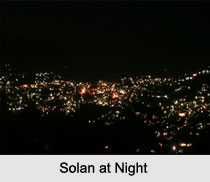 Solan in Solan District of Himachal Pradesh is located between Kalka and Shimla. These are the popular hill stations nearby.
Solan in Solan District of Himachal Pradesh is located between Kalka and Shimla. These are the popular hill stations nearby.
Location of Solan
This "Mushroom city of India" is located in between 30 Degree 05 minutes and 31 degree 15 minutes North Latitude and 76 degree 42 minutes and 77 degree 20 minutes East Longitude. The average elevation is about 1502 meters.
History of Solan
Solan is converted into a hill station during the rule of British Empire in India. Famous `Mohan Meakin`s Brewery` established in 1855 A.D resides in Solan.
Geography of Solan
Geography of Solan denotes that this city is bordered with Shimla district in North, by Ropar district of Punjab and Ambala district of Haryana in the South, by Sirmaur district in the East and Bilaspur district in the West. Mandi district touches the boundary of Solan in the North-Eastern part. 
Climate of Solan
The climate of "City of Red Gold" remains cool and temperate through out the year. The summer temperature ranges from 32 degree Celsius and the winter temperature is about -4 degree Celsius.
Tourism in Solan
Tourism in Solan defines the scope of trekking, mountaineering and fishing. Solan district is covered by catchments areas of three important rivers, namely Sutlej River, Yamuna River and Ghagar. Eco Tourism Parks played an important role in promoting the tourism in Solan.
Parwanoo
Parwanoo is a commercial and industrial city located in Shivalik hills on the Kalka-Shimla highway. Parwanoo has a large number of small and medium scale industries.
Kasauli
Kasauli is located at 77 km. from Kalka. It is located at an altitude of 2,107 meters. It is a very good place for relaxation. Kasauli is popular for the English styled bunglows and the home stays. The town remained snowy during winter months.
Barog
Barog is an attractive place, which is located just 37 km. from Kalka and 5 km. from Solan. It was an important stop on the railway line in the early part of the century. The hill train halted for an hour here, while the travellers indulged in a lavish traditional lunch. Surrounded by the Pine forests, this place is popularly known for the luxury home stays.
Arki Fort
It is the sub-division headquarter and is situated at 39 km. from Shimla and 7 km. from Shalaghat on Shimla-Bilaspur road. It was the capital of Parmara Dynasty in ancient history. The King`s palace is an example of the ancient art.
Visiting Information
Solan is connected by roadways, railways and airways. The nearest airport to reach Solan is Chandigarh 48 km. and Shimla 68 km. Kalka-Shimla narrow gauge rail head is the nearest railway connection. Solan is well linked with road from all the districts of Himachal Pradesh. Himachal Pradesh Road Transport Corporation has a huge network to provide communication. It is about 315 km from Delhi, Kalka (42 km), Chandigarh (68 km). and Shimla 48 km.



















